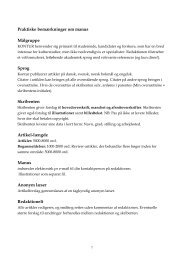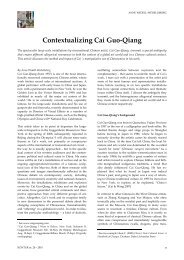Akasegawa Genpei as a Populist Avant-Garde An ... - Kontur
Akasegawa Genpei as a Populist Avant-Garde An ... - Kontur
Akasegawa Genpei as a Populist Avant-Garde An ... - Kontur
You also want an ePaper? Increase the reach of your titles
YUMPU automatically turns print PDFs into web optimized ePapers that Google loves.
compared with one of <strong>Ak<strong>as</strong>egawa</strong>’s pre-Cheerleaders<br />
publications intended for the general readership. On<br />
the cover of How to Enjoy the Louvre Museum of<br />
1991,(<strong>Ak<strong>as</strong>egawa</strong> and Kum<strong>as</strong>egawa 1999) he shows his<br />
back to the reader in an un-photogenic posture of<br />
squatting before the monumental The Coronation of<br />
Napoleon by Jacques-Louis David. The design’s focus is<br />
not <strong>Ak<strong>as</strong>egawa</strong> but a well-known painting by the<br />
French m<strong>as</strong>ter. Something changed the publishing<br />
industry’s perception of <strong>Ak<strong>as</strong>egawa</strong> between the Louvre<br />
book and the Cheerleaders series. Indeed, a great deal<br />
had changed since the 1960s when he w<strong>as</strong> known<br />
primarily <strong>as</strong> a cult figure of underground culture.<br />
From Model 1,000-Yen Note Incident to Tom<strong>as</strong>on<br />
<strong>Ak<strong>as</strong>egawa</strong> w<strong>as</strong> a major player in what I called the<br />
“expanded 60s” in Japan. What I define <strong>as</strong> the<br />
expanded sixties spans from 1954 to 1974, from the<br />
avant-garde group Gutai to the collective Bikyōtō,<br />
characterized by the rise of <strong>An</strong>ti-Art (Han-geijutsu) and<br />
Non-Art (Hi-geijutsu). In plain terms, <strong>An</strong>ti-Art and<br />
Non-Art are Japanese manifestations of the radical<br />
experimentation in the are<strong>as</strong> of conceptualism,<br />
installation art, and performance art. As such, the<br />
expanded 1960s is the time of dematerialization and<br />
ephemerality, when the idea of gendai bijutsu, or<br />
literally “contemporary art,” emerged in Japan, distinct<br />
from nihon-ga (Japanese-style painting) and yōga<br />
(Western-style painting), two major are<strong>as</strong> of modern<br />
practice established in the late 19th century. 12<br />
A member of Neo Dada (initially known <strong>as</strong> “Neo<br />
Dadaism Organizer[s]”), a short-lived yet important<br />
group, <strong>Ak<strong>as</strong>egawa</strong> w<strong>as</strong> a central figure in <strong>An</strong>ti-Art,<br />
which constituted the fervent <strong>as</strong>sault on the modern<br />
construct of “Art” with a capital A, or geijutsu. As the<br />
critic Miyakawa Atushi theorized, <strong>An</strong>ti-Art is<br />
characterized by its “descent to the everyday,” which<br />
could manifest itself through the proliferation of<br />
everyday objects and the infiltration of everyday space.<br />
One of <strong>Ak<strong>as</strong>egawa</strong>’s contributions in the object making<br />
w<strong>as</strong> Vagina’s Sheet, he created in 1961 with rubber<br />
linings of discarded automobile tires and vacuum tubes.<br />
He showed it at the Yomiuri Independent Exhibition<br />
12 For 1960s art in Japan, recent literature includes Merewether<br />
et al. 2007, which offers an extensive bibliography in pages<br />
130–33. Other key publications in the field are Munroe 1994<br />
and Tomii 2005. For <strong>Ak<strong>as</strong>egawa</strong>’s works, see Tomii 2002a;<br />
Marotti, 2001.<br />
KONTUR nr. 20 – 2010<br />
REIKO TOMII<br />
held at the Tokyo Metropolitan Art Museum, which<br />
had become the hotbed of <strong>An</strong>ti-Art since 1958. He w<strong>as</strong><br />
also a member of Hi Red Center, another short-lived<br />
<strong>An</strong>ti-Art group (act. 1963–64) known for performanceb<strong>as</strong>ed<br />
events. In the iconic act of infiltrating the public<br />
sphere, Hi Red Center staged Cleaning Event in 1964, in<br />
the midst of the Tokyo Olympic Games. In critique of<br />
the official beautification campaign, through which the<br />
government aimed to present the capital to foreign<br />
visitors in the best possible light, the group members<br />
and <strong>as</strong>sociates painstakingly cleaned the busy streets of<br />
Ginza in Tokyo, using such household cleaning tools <strong>as</strong><br />
a toothbrush, a floorcloth (or zōkin), and a taw<strong>as</strong>hi brush.<br />
<strong>Ak<strong>as</strong>egawa</strong> swept the paved street with a shorthandled<br />
soft bloom made for sweeping a tatami floor.<br />
To understand <strong>Ak<strong>as</strong>egawa</strong>’s transition from a<br />
subversive vanguardist to an accessible public figure in<br />
mainstream culture, we need to look at three projects<br />
that intersected with the public sphere with far greater<br />
consequences than Cleaning Event, which remained<br />
clandestine and thus “nameless” (mumei).<br />
Model 1,000-Yen Note Incident<br />
Fig 2: Model 1,000-Yen Note [Green] (1963)<br />
His epic-scale Model 1,000-Yen Note Incident came<br />
straight out of his <strong>An</strong>ti-Art experiment. Spanning from<br />
1963 to 1974, Model 1,000-Yen Note Incident is a v<strong>as</strong>t<br />
matrix of conceptualist works and discursive practices<br />
produced by <strong>Ak<strong>as</strong>egawa</strong> with other artists and nonartists.<br />
As an artist’s project, it began with <strong>Ak<strong>as</strong>egawa</strong>’s<br />
photomechanical replica of the 1,000-yen note<br />
fabricated in 1963, which he came to call Model 1,000-<br />
Yen Note (Fig 2). This money work inadvertently<br />
39




